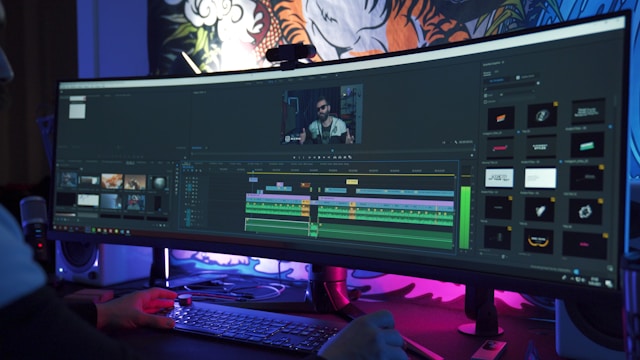We’ve had sound cinema for almost a century now, but have you ever wondered how it’s done? In this article, we will tell you more about the art of sound recording and sound design, so you can learn how your favourite films were made.
Many people underestimate the difficulty of both disciplines which is why we wanted to honour the brilliant recordists and designers who often become the unsung heroes of filmmaking.
Job Description
In the following two sections, we will tell you in length what sound recordists and sound designers do in filmmaking.
What a Sound Recordist Does
Sound recording is the process of recording audio elements for a film production. What many might not realise is the number of different audio elements that a recordist has to capture. The obvious is dialogue and monologue as the actors are delivering them, but that’s only scratching the surface.
A sound recordist additionally records ambient noises of each film location. Usually, after all the scenes are filmed at a certain location, the cast and crew would leave to allow the recordist capture the ambient sound of the said location.
Some might wonder why a recordist records a silent room, the room is never actually silent. Soundwaves travel and bump at any object in a room, so every room has its own tune so to speak. We will discuss how sound designers use ambient noise later.
Another thing that a sound recordist does is record foley (this usually refers to smaller productions because expensive films have designated foley artists). Foley recording is the capturing of real-life sounds, like the sound of wood crackling in a fireplace, in order to emphasise diegetic (in universe) sounds.
When you’re on set, you might think that your actors steps can be heard in the recording of the take, but that’s not always the case as the microphone is always directed at the actor’s mouth, so you need to record foley (best done on the day) to make the sound “pop”.
A recordist can also capture extra-diegetic sound effects to be used in editing such as that of a glass breaking (yes, we refer to the famous How I Met Your Mother episode when each of the main characters hears a glass breaking when they realise their friends’ annoying habits for the first time).
Sound recordists might also take part in dubbing if the feature is animated, or to redo certain scenes in live action features (known as ADR or automatic dialogue replacement). Naturally, big productions have different people for dialogue recording and ADR.
Notable mention: The sound recordist is usually not the person pointing the microphone at actors. The sound recordist places lavalier (or lav) microphones on actors and directs where the big microphones are pointing, but it’s the boom operator who holds the microphone and follows actors around.
The sound recordist listens to the take as it’s happening and directs the boom operators if unhappy with the sound quality. The recordist can then ask the director for a cut and another take if there were any issues with the microphones and their placement (clothes crinkling pose a big problem to lav mics).
What a Sound Designer Does
The sound designer’s job is to combine all sounds recorded for the film, including dialogue/monologue, ambience, sound effects and soundtrack. Sometimes, a designer might create additional sound effects digitally. People generally understand that sound editing is important but much like sound recording, many don’t know all that comes with it.
If, for example, the dialogue in a scene was recorded perfectly and everything is intelligible, some may wonder why the designer is touching the track at all, though if they were to watch the scene with unedited sound, they will appreciate the hard work of sound designers.
Even if the actor’s speech is intelligible and eloquent, the scene might still appear mediocre if the sound levels are not perfectly equalised and the volume is “inappropriate” for the tone of the scene.
Moreover, a scene can look stilted if the actor’s voice is the only thing you can hear. This is where ambiance comes in. The designer always, and we cannot stress this enough, uses and edits the ambient noise captured by the recordist. If you were to look at a film’ timeline in an editing software, you can see an ambient track throughout the whole film.
If the production cannot afford ADR and there are no “perfect” recordings of a take, the sound designer would try to salvage that as much as possible. The sound recordist is responsible for the capture of high-quality sound, but anyone who has ever edited a film knows that some mistakes only come to light in post-production.
Following that, the sound designer would add the sound effects recorded by the foley artist and edit them to improve their quality. If necessary, the sound designer would create sound effects or borrow existing ones (paying for copyright if they have to). Usually, those sound effects would be digital.
Lastly, the sound designer would place non-diegetic music (one that characters cannot hear) on the timeline by picking when the music starts and ends based on the shots, and then they would master the music track. A designer might also replace recorded diegetic music (in universe music) with one recorded in a studio whose quality is naturally better.

